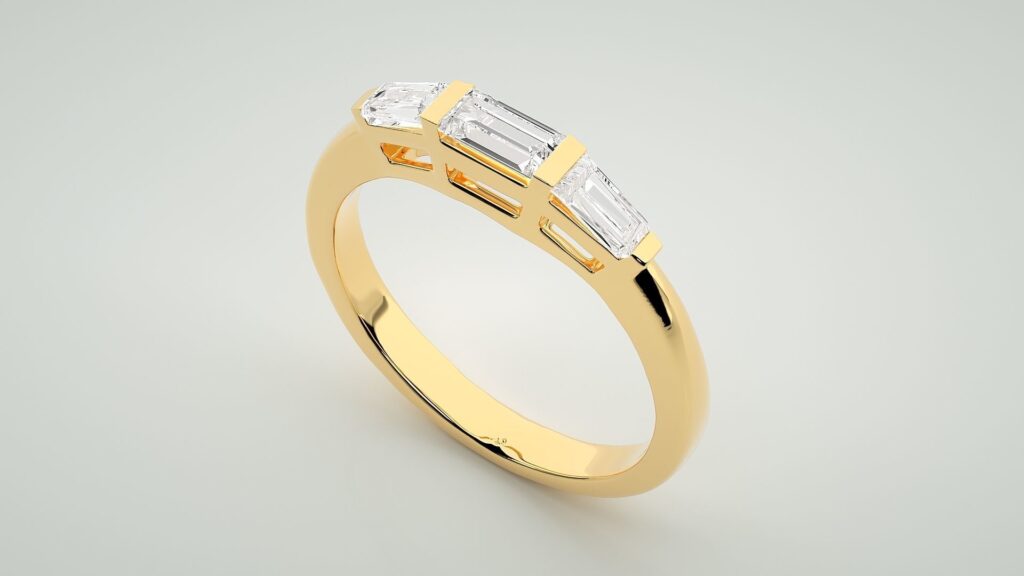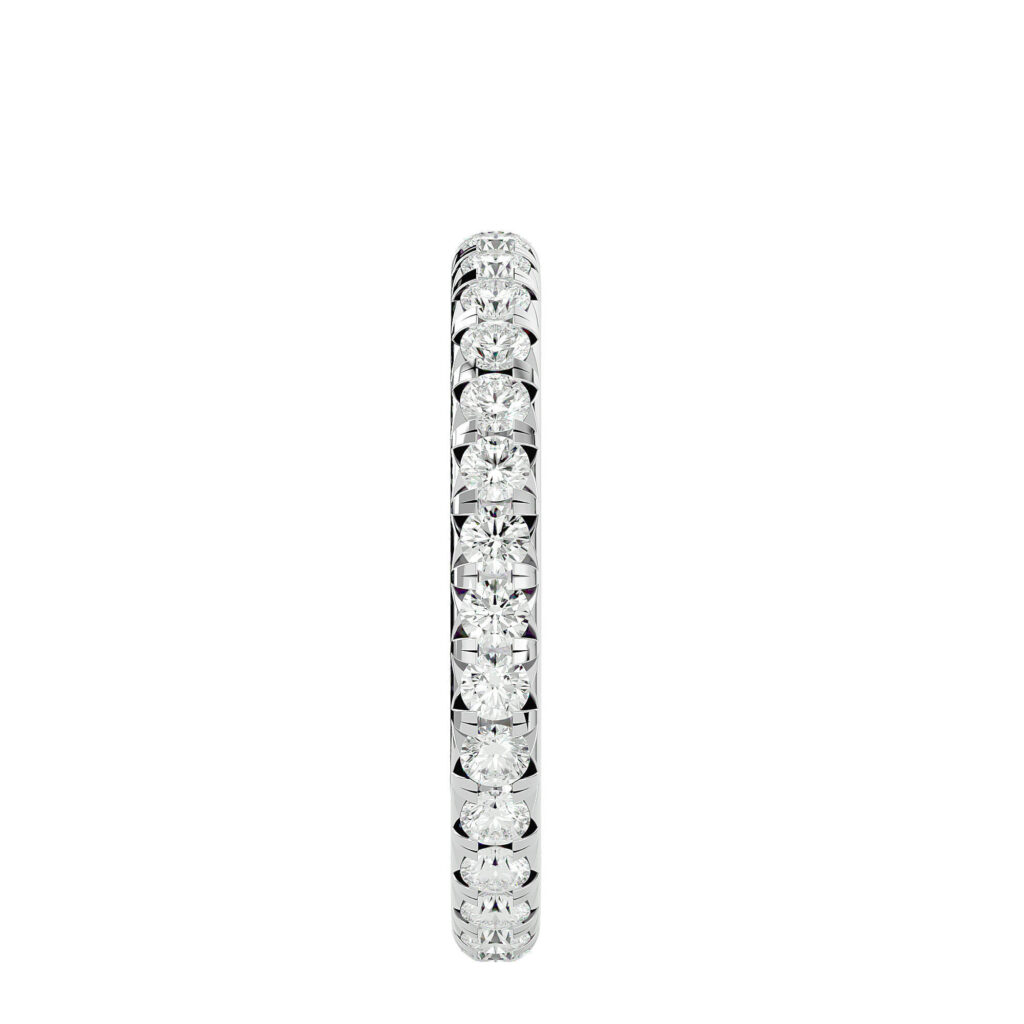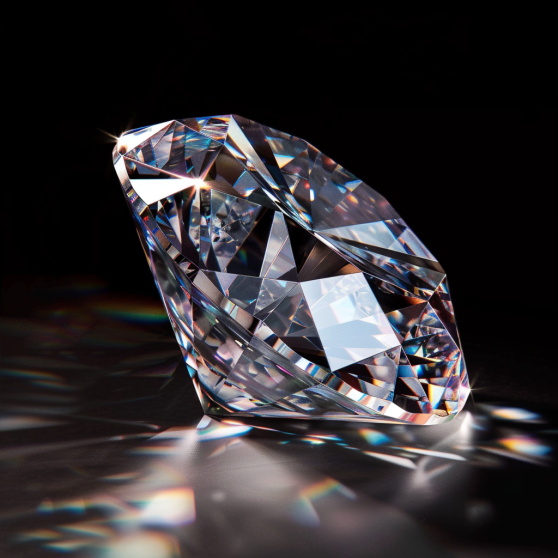Precious Metals
DIAMOND CUTLET THE HIDDEN BRILLIANCE OF DIAMONDS
A diamond cut is a key factor to consider when choosing your next piece of diamond jewelry.
By Chinwe, Chief Creative Officer
Diamonds have captivated humanity for centuries with their unparalleled beauty and mystique. While much attention is given to the famous “Four Cs” of diamond quality—cut, color, clarity, and carat weight—there’s one often overlooked feature that plays a crucial role in a diamond’s appearance and value: the culet. The culet, located at the bottom tip of a diamond, may seem small and inconsequential, but its presence—or absence—can greatly impact the diamond’s brilliance, durability, and overall aesthetic appeal. In this article, we delve into the fascinating world of diamond culets, tracing their historical significance, dissecting their anatomy, exploring grading systems and offering practical buying advice.

The Anatomy of the Diamond Culet
The culet refers to the bottom facet of a diamond, typically located at the apex of the diamond’s pavilion (the lower portion of the diamond). It’s often described as the diamond’s “point” or “tip.” In well-cut diamonds, the culet is usually a small, flat facet created during the diamond polishing process. However, in certain antique or fancy-cut diamonds, the culet may be more prominent and can take on various shapes such as pointed, knife-edge, or faceted.
The primary purpose of a diamond culet is to protect the delicate tip of the diamond during the cutting and polishing process. Without a culet, the diamond’s point would be vulnerable to damage, potentially compromising the diamond’s structural integrity. Additionally, the culet helps to facilitate the proper alignment of the diamond during cutting and setting, ensuring symmetry and balance in the finished piece of jewelry. Overall, the culet contributes to the diamond’s durability and aesthetics, playing a crucial role in its overall quality and longevity.
Importance of Culets
-
Round Brilliant Cut Wedding Engagement Ring 18K Gold- 0.030ct
18K Gold
£1,100 Select options This product has multiple variants. The options may be chosen on the product page -
Solitaire Wedding Ring – 18K Gold 0.36ct
18K Gold
£1,900 Select options This product has multiple variants. The options may be chosen on the product page -
Trilogy Baguette Eternity Band Ring – 18K Rose Gold – 0.74ct
18K Rose Gold
£2,100 Select options This product has multiple variants. The options may be chosen on the product page -
Trilogy Wedding Engagement Ring – 18K Rose Gold 0.59ct
18K Rose Gold
£2,500 Select options This product has multiple variants. The options may be chosen on the product page
Despite its small size, the culet plays a significant role in determining a diamond’s appearance, brilliance, and durability. The following points explain why the culet is important:
- Brilliance and Light Performance: The culet affects how light interacts within the diamond. A properly proportioned culet helps to reflect and refract light within the diamond, enhancing its brilliance and sparkle. However, an overly large or improperly placed culet can lead to light leakage, reducing the diamond’s brilliance.
- Durability and Structural Integrity: In diamonds with pointed or very small culets, the risk of chipping or damage to the culet is higher, especially during setting or everyday wear. A well-defined culet helps to minimize this risk by providing a smooth surface at the bottom of the diamond.
- Visual Appeal: The presence or absence of a culet can also affect the diamond’s visual appearance. Some prefer the clean, crisp look of a diamond with no culet (a “pointed” or “closed” culet), while others appreciate the added depth and character provided by a small culet.
Types of Culets

There are various types of culets, each type offering its own blend of aesthetic appeal, durability, and light performance, allowing diamond buyers to choose the option that best suits their preferences and style.
- Pointed Culet: A pointed culet refers to a diamond culet that features a small, sharp tip at the bottom of the diamond. This type of culet creates a clean, crisp look and is often associated with traditional brilliant cuts, such as round brilliants. Pointed culets are designed to help direct light towards the center of the diamond, enhancing its brilliance and sparkle. They contribute to the overall symmetry and aesthetic appeal of the diamond, providing a refined and elegant appearance.
An advantage of pointed culets is their ability to minimize light leakage and maximize light reflection within the diamond, resulting in optimal brilliance and fire. Additionally, pointed culets are less prone to collecting dirt or debris compared to flat or larger culets, helping to maintain the diamond’s clarity and cleanliness over time.
However, one potential disadvantage of pointed culets is their increased susceptibility to chipping or damage, especially during setting or everyday wear. The sharp tip of the culet may be more vulnerable to impact and may require careful handling and maintenance to prevent damage.
Overall, pointed culets offer a classic and timeless look to the diamond, while also enhancing its light performance and overall beauty. They are a popular choice for those seeking a traditional and elegant diamond appearance with optimal brilliance and sparkle. - Flat Culet: A flat culet refers to a diamond culet that features a small, flat facet at the bottom of the diamond. This type of culet provides a stable surface for the diamond to rest on and helps minimize the risk of chipping or damage to the diamond’s tip. Flat culets are commonly found in step-cut diamonds, such as emerald cuts or Asscher cuts, where larger, broader facets are arranged in parallel steps. Flat culets are stable and durable. They provide a flat surface at the bottom of the diamond and help distribute pressure evenly, reducing the likelihood of damage during setting or everyday wear. Additionally, flat culets contribute to the overall symmetry and balance of the diamond, enhancing its aesthetic appeal.
Flat culets also offer practical benefits in terms of maintenance and cleanliness. Unlike pointed culets, which may be more prone to collecting dirt or debris, flat culets are easier to clean and maintain, helping to preserve the diamond’s clarity and brilliance over time. One drawback of flat culets is their impact on light performance. Compared to pointed culets, which help direct light towards the center of the diamond, flat culets may not optimize light reflection as effectively. As a result, diamonds with flat culets may exhibit slightly less brilliance and sparkle. - Faceted Culet: A faceted culet refers to a diamond culet that features multiple small facets at the bottom of the diamond, creating a unique pattern. This type of culet adds depth and character to the diamond’s appearance, enhancing its overall beauty and visual interest. Faceted culets are often found in diamonds with intricate cutting styles, such as antique cuts or fancy shapes like hearts or pears.
One of the key advantages of faceted culets is their ability to enhance light reflection and dispersion within the diamond. The multiple facets create additional surfaces for light to interact with, resulting in increased brilliance and sparkle. Faceted culets can also help disguise minor imperfections or inclusions near the culet area, improving the diamond’s overall clarity and appearance. They also offer versatility in design and style, allowing for a range of creative possibilities. Diamond cutters can customize the number, size, and arrangement of facets to achieve different optical effects and aesthetic preferences. Additionally, faceted culets can complement the overall design of the diamond, adding a touch of elegance and sophistication.
However, one potential consideration with faceted culets is their maintenance and cleaning. The intricate facets may require more careful attention to keep clean and free of debris, especially in hard-to-reach areas. Regular cleaning and maintenance can help preserve the brilliance and clarity of diamonds with faceted culets over time. - Knife-Edge Culet: A knife-edge culet refers to a diamond culet that features a sharp, thin edge resembling the edge of a knife. This type of culet offers a sleek and contemporary look to the diamond, adding visual interest and sophistication. Knife-edge culets are often found in modern cutting styles and fancy shapes, where the clean lines and geometric designs complement the overall aesthetic.
knife-edge culets have a modern and distinctive appearance. The sharp, thin edge of the culet adds a touch of elegance and sophistication to the diamond, enhancing its overall aesthetic appeal. Knife-edge culets can also contribute to the diamond’s perceived size, as the sharp edge creates the illusion of a larger diamond.
It also offers a versatility in design and style, allowing for a range of creative possibilities. Diamond cutters can customize the width and angle of the knife-edge culet to achieve different optical effects and aesthetic preferences. Additionally, knife-edge culets can complement a variety of diamond shapes and cutting styles, making them a versatile choice for modern jewelry designs. However, one potential consideration with knife-edge culets is their durability and susceptibility to damage. The sharp edge of the culet may be more prone to chipping or wear compared to other culet types. Careful handling and maintenance are necessary to prevent damage to the culet and preserve the diamond’s overall integrity. - 5. Polished Culet: Polished culets are a variation where the bottom facet of the diamond, instead of being faceted or pointed, is smoothed and polished to create a flat, reflective surface. This type of culet offers a clean, sleek look to the diamond, with the smooth surface contributing to its overall symmetry and aesthetic appeal.
Polished culets are often found in diamonds with certain cutting styles, such as the modern brilliant cut, where the focus is on maximizing brilliance and sparkle. By eliminating facets or sharp edges at the bottom of the diamond, polished culets reduce the risk of light leakage and help maintain a consistent flow of light within the stone, enhancing its overall brilliance.
One advantage of polished culets is that they are less prone to chipping or damage compared to faceted or pointed culets. The smooth surface of a polished culet provides a stable foundation for the diamond, minimizing the risk of wear and tear over time.
Overall, polished culets offer a sleek and contemporary look to the diamond, while also contributing to its durability and light performance. They are a popular choice for diamonds in modern jewelry designs, where the focus is on maximizing brilliance and achieving a clean, minimalist aesthetic.

Culets and Diamond Cutting Techniques.
The historical perspective of culets provides insights into the evolution of diamond cutting techniques, changing fashion trends, and the significance of culets in antique diamonds. Historically, culets have varied in importance and prominence depending on the era and prevailing cutting styles.
In ancient times, diamonds were often left in their natural octahedral shape, with minimal faceting or polishing. As diamond cutting techniques evolved, particularly during the Renaissance and Baroque periods, culets became more prominent in diamond cutting. Diamonds were often cut with large, flat culets, reflecting the cutting styles of the time.
During the 18th and 19th centuries, advancements in diamond cutting technology led to the development of more intricate cutting styles, such as the Old Mine Cut and the Old European Cut. These cuts often featured smaller culets and emphasized the diamond’s brilliance and fire.
In the Art Deco era of the 1920s and 1930s, geometric shapes and bold designs were popular in jewelry. Diamonds were often cut with square or rectangular shapes and small, pointed culets to complement the sleek, angular designs of the time.
In more recent decades, modern cutting techniques have allowed for greater precision and flexibility in diamond cutting. Culets may vary in size, shape, and placement to accommodate different design preferences and maximize the diamond’s beauty and performance. They have remained an integral part of diamond cutting and continue to influence the aesthetics and design of diamonds in contemporary jewelry.
Some commonly used cutting techniques and their influence on the culets formed include:
- Traditional Brilliant Cut: In the traditional brilliant cut, which is one of the most common cutting styles for diamonds, the diamond has a pointed culet. This cutting technique emphasizes maximizing the diamond’s brilliance and sparkle by creating a series of carefully aligned facets. The pointed culet helps to direct light towards the center of the diamond, enhancing its overall brilliance.
- Step Cut: In step-cut diamonds, such as emerald or Asscher cuts, the culet is typically flat or slightly pointed. Step cuts feature larger, broader facets arranged in parallel steps, which create a hall-of-mirrors effect. The culet in step-cut diamonds is designed to complement the clean lines and geometric shapes of these cuts, providing stability and minimizing the risk of chipping or damage.
- Fancy Cut: Fancy cuts, including pear, marquise, and heart shapes, offer more flexibility in culet design. Depending on the specific cutting style and the preferences of the diamond cutter, fancy-cut diamonds may have pointed, flat, or even faceted culets. The choice of culet shape in fancy-cut diamonds is often influenced by aesthetic considerations, such as symmetry and balance, as well as practical concerns, such as durability and light performance.
- Antique Cuts: Antique diamond cuts, such as old mine cut or old European cut, often feature larger, more prominent culets to modern cuts. These cuts were developed before modern cutting techniques and may exhibit a variety of culet shapes, including pointed, flat, or even faceted. The culet in antique cuts reflects the historical context and cutting practices of the time, adding to the charm and character of these diamonds.
Practical Considerations for Buyers
When selecting a diamond culet, there are several practical considerations to keep in mind to ensure you choose a diamond culet that enhances the overall beauty, durability, and performance of the diamond, ensuring you choose a diamond that meets your specific preferences and requirements.
- Appearance: Consider the overall appearance and aesthetic appeal of the culet. Decide whether you prefer a pointed, flat, faceted, or knife-edge culet based on your personal style and design preferences. Additionally, consider how the culet shape complements the overall shape and design of the diamond.
- Size: Pay attention to the size of the culet in relation to the diamond’s overall proportions. Smaller culets are generally preferred as they contribute to better light reflection and minimize the risk of visibility. However, ensure the culet is not too small to the point of being non-existent, as this may affect light performance.
- Visibility: Assess the visibility of the culet under different lighting conditions and angles. Ensure the culet is not overly large or misaligned, as this may be visible to the naked eye and affect the diamond’s overall aesthetics. Opt for a culet that blends seamlessly with the rest of the diamond’s facets.
- Symmetry: Evaluate the symmetry of the culet in relation to the rest of the diamond’s facets. Ensure the culet is well-centered and properly aligned to contribute to the overall symmetry and balance of the diamond. Off-center or misaligned culets may detract from the diamond’s appearance.
- Durability: Consider the durability and stability of the culet. Choose a culet type that offers sufficient stability and minimizes the risk of chipping or damage, especially if the diamond will be worn regularly or subjected to everyday wear and tear.
- Light Performance: Evaluate how the culet type and size affect the diamond’s light performance and brilliance. Consider whether the culet optimizes light reflection and dispersion within the diamond, contributing to its overall sparkle and fire.
Certification: Review the diamond’s certification report, which typically includes information about the culet size, shape, and quality. Ensure the diamond’s culet meets your desired specifications and aligns with your preferences.
-
Choupette Ring – 18K Rose Gold 2.6ct
18K Gold
£3,550 Select options This product has multiple variants. The options may be chosen on the product page -
Constellation Ring – 18K White Gold 4.65ct
18K White Gold
£6,500 Select options This product has multiple variants. The options may be chosen on the product page -
Sale!
Platinum Emerald Cut Wedding Engagement Ring
Platinum 950
£17,500 Select options This product has multiple variants. The options may be chosen on the product page OUT OF STOCK -
Princess Cut Ring – 18K White Gold – 1.78ct
18K White Gold
£2,800 Select options This product has multiple variants. The options may be chosen on the product page
In conclusion, understanding the significance of culets and considering practical factors such as size, visibility, and symmetry can empower buyers to make informed decisions when selecting the perfect diamond. Whether seeking timeless elegance, modern sophistication, or unique flair, the right culet can elevate a diamond from mere gemstone to a radiant symbol of beauty and excellence. As we navigate the multifaceted world of diamonds, let us not overlook the importance of the humble culet, for it holds the key to unlocking the true brilliance and allure of these precious gemstones.

